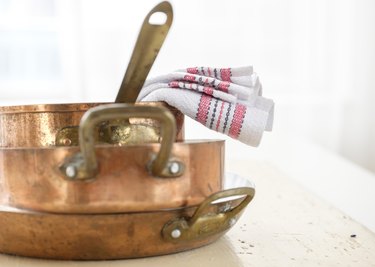
There's a good reason copper cookware is passed down from generation to generation. Pans made from copper can last for decades, and they actually get better with age if you like the look of the patina that forms on copper over time. Your copper pans might be your favorite cookware in your kitchen from an aesthetic standpoint, but they have plenty of practical value too. You can bake in copper pans just the way you would use glass or other kinds of metal bakeware.
Why Use Copper in Cooking?
Video of the Day
People have been cooking with copper vessels for thousands of years. The main benefit of using copper in cooking is that copper is a good conductor of heat, so copper baking pans heat up quickly and cook foods evenly. Note that copper pans are always lined with some sort of nonreactive metal, typically tin or stainless steel, which keeps food from making any direct contact with the copper. (Don't add food to a pan if you can see any hints of copper shining through the worn lining.)
Video of the Day
Other than its aesthetic appeal and its good heat conductivity, copper doesn't have any major advantages that make it superior to other kinds of bakeware. One potential downside of cooking with copper pans is that food may stick to a stainless steel lining; this isn't an issue with tin linings, however.
Baking in Copper Pans
Generally speaking, copper baking pans can be used just like any other baking pan. Follow your recipe's instructions for oiling or preheating the pan. You don't need to adjust cooking time or take special precautions because you're using copper pans.
However, be careful about using copper at high heat. A copper pan that's lined with tin shouldn't be exposed to temperatures above 430 degrees Fahrenheit, or it can be damaged. Play it safe by using these pans only for recipes that call for temperatures below 425 degrees and don't broil anything in a copper pan.
Cleaning Copper Pans
Because they're lined with tin or another kind of metal, the inside of your copper baking pans shouldn't be especially difficult to clean. You can safely use regular dish soap and a soft sponge (not an abrasive scrubber) to scrub the pan clean unless the manufacturer's care instructions say otherwise. It should be safe to use the same sponge to clean any food debris or baked-on crud from the outside of the pan too.
Never wash copper pans in the dishwasher, which can cause tarnish and/or corrosion to the metal.
Long-Term Care for Copper Pans
The copper exterior of your pans will naturally darken and develop a rich bronze patina over time. Many people love the look of the patina and consider it a bonus of using copper in cooking. The older cookware gets, the more deep and interesting its color becomes.
But if you prefer the bright, pinky shade of new copper, polishing your older pans should bring that color back. Use copper polish or the classic home remedy of salt and lemon juice or white vinegar. Work the polish or salt mixture into the copper with a soft cloth until you're satisfied with the results and then rinse it under running water and dry it with a clean, soft cloth.
Tin-lined copper baking pans that have been used for many years may need to be re-tinned as the lining begins to wear away. Wait to pay for professional re-tinning until you see copper coming through the lining . The manufacturer that made your copper pans may connect you with a professional re-tinner. They'll melt and scrape away the old lining and pour a new tin lining. Copper pans lined with stainless steel don't need this kind of repair.